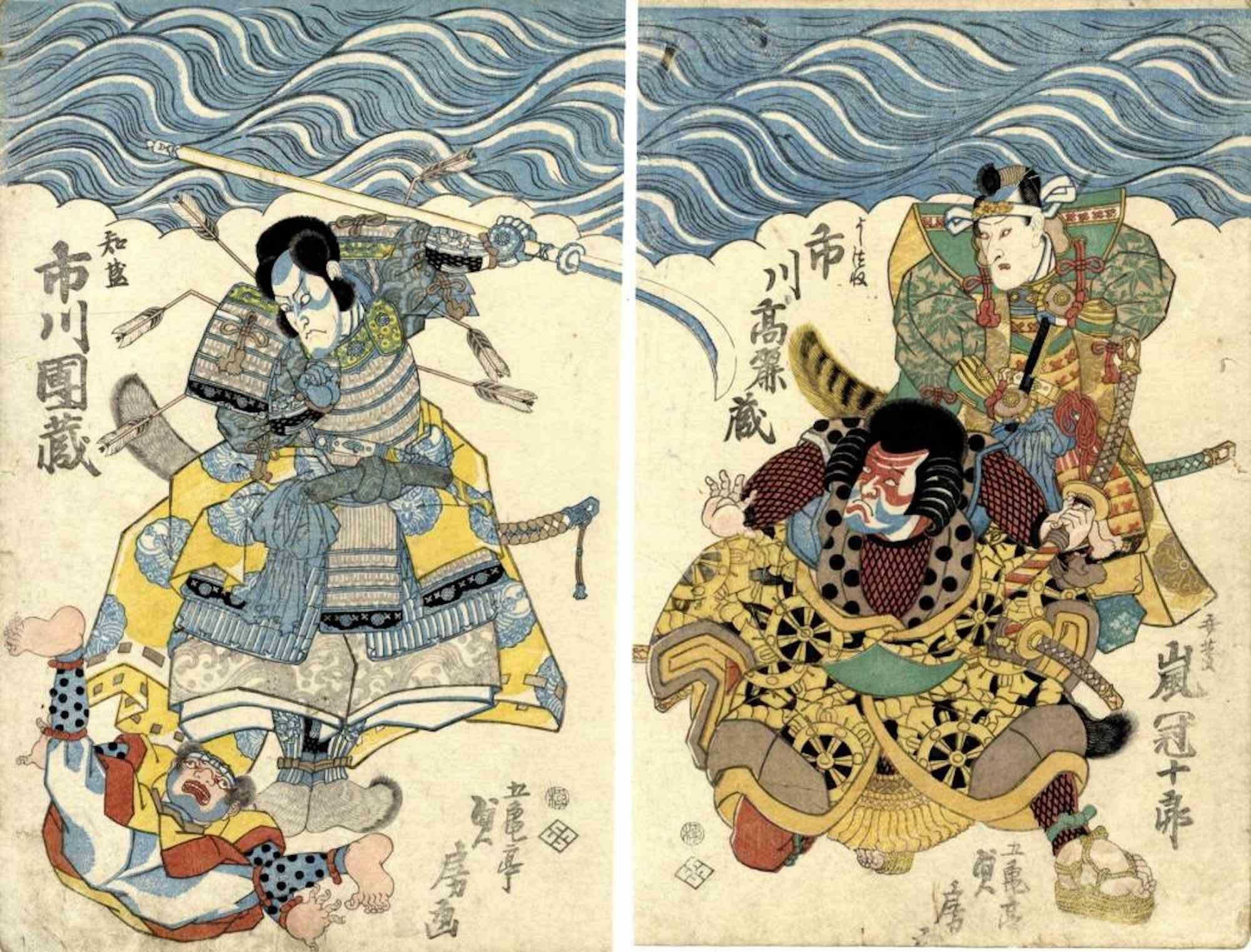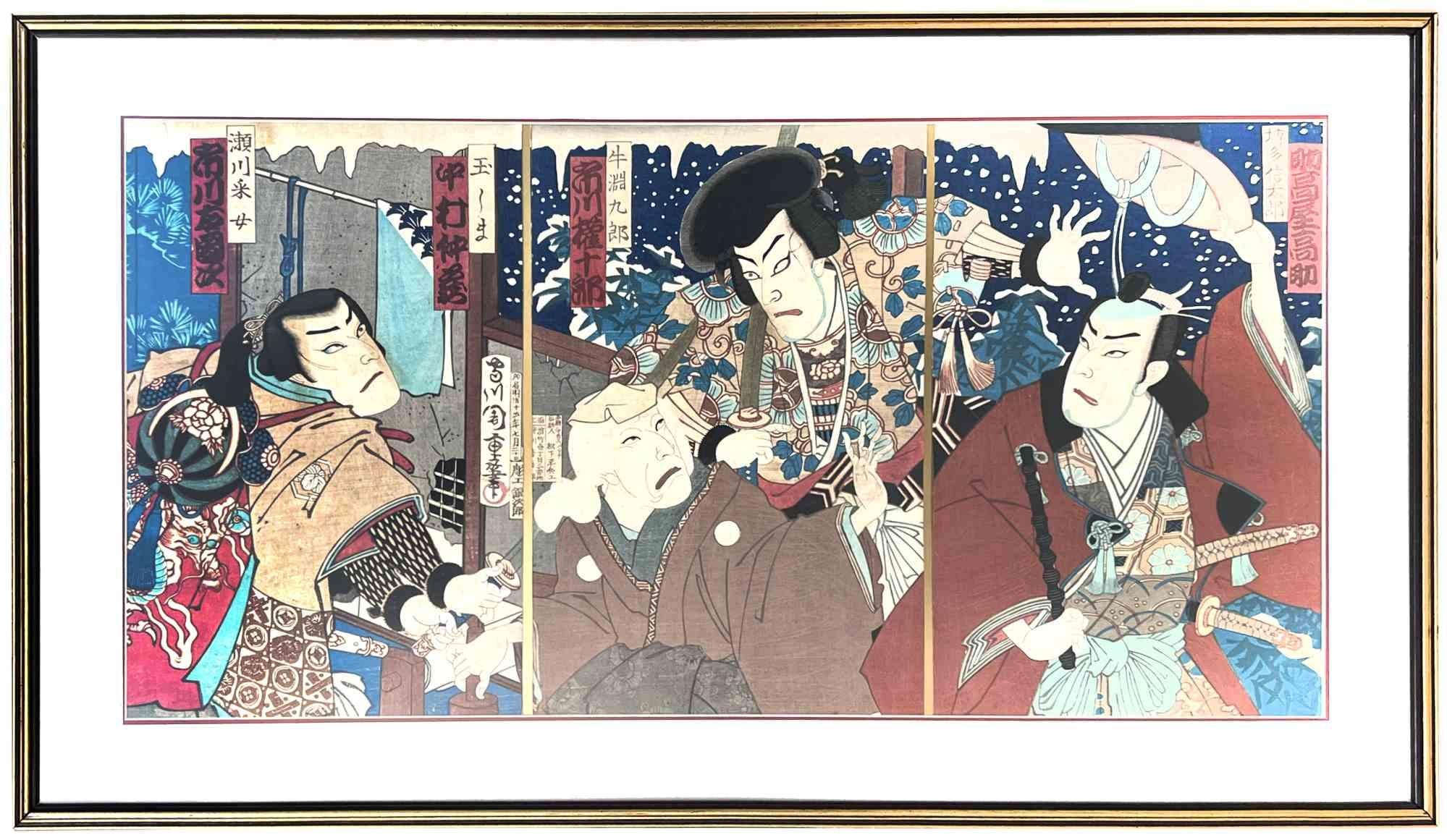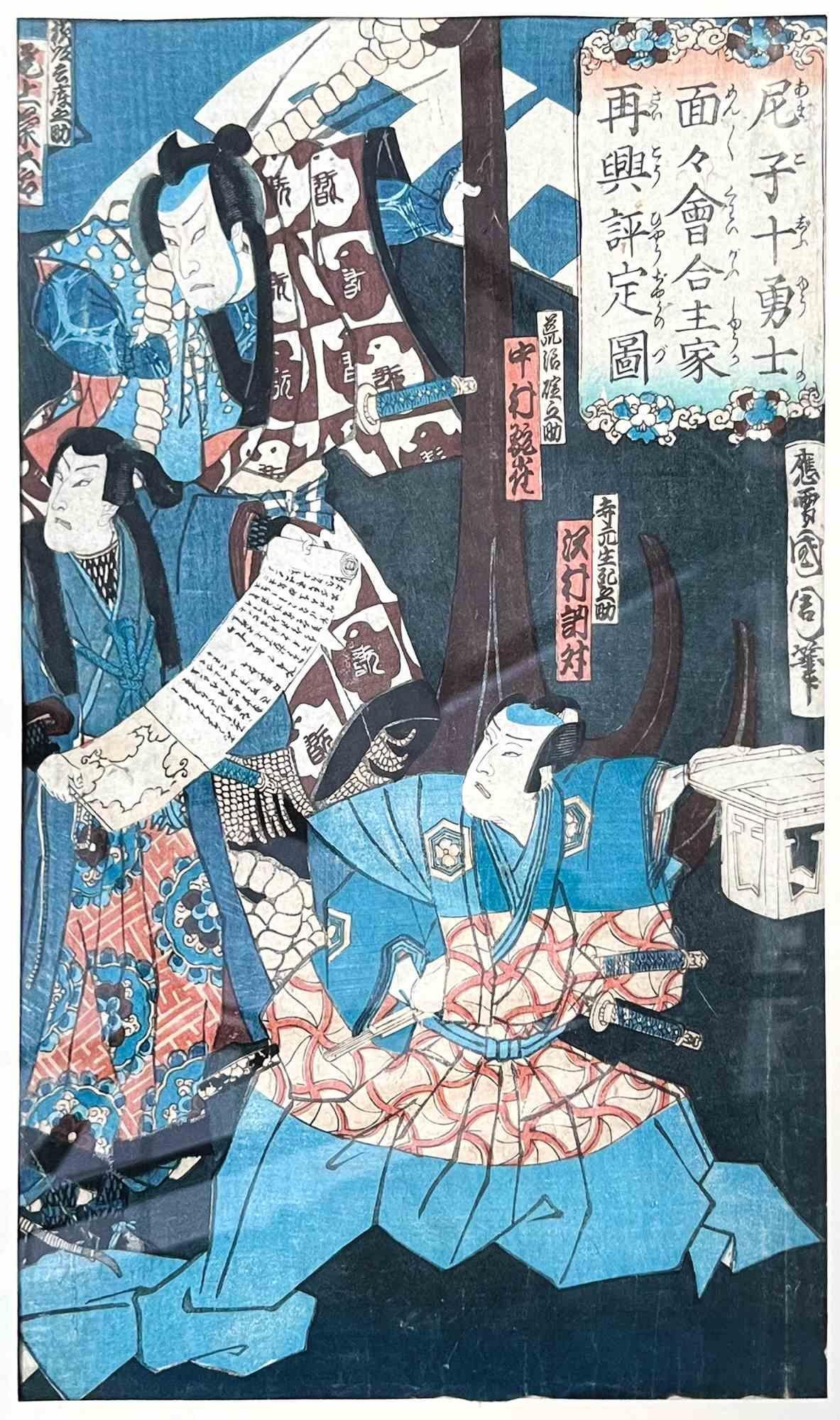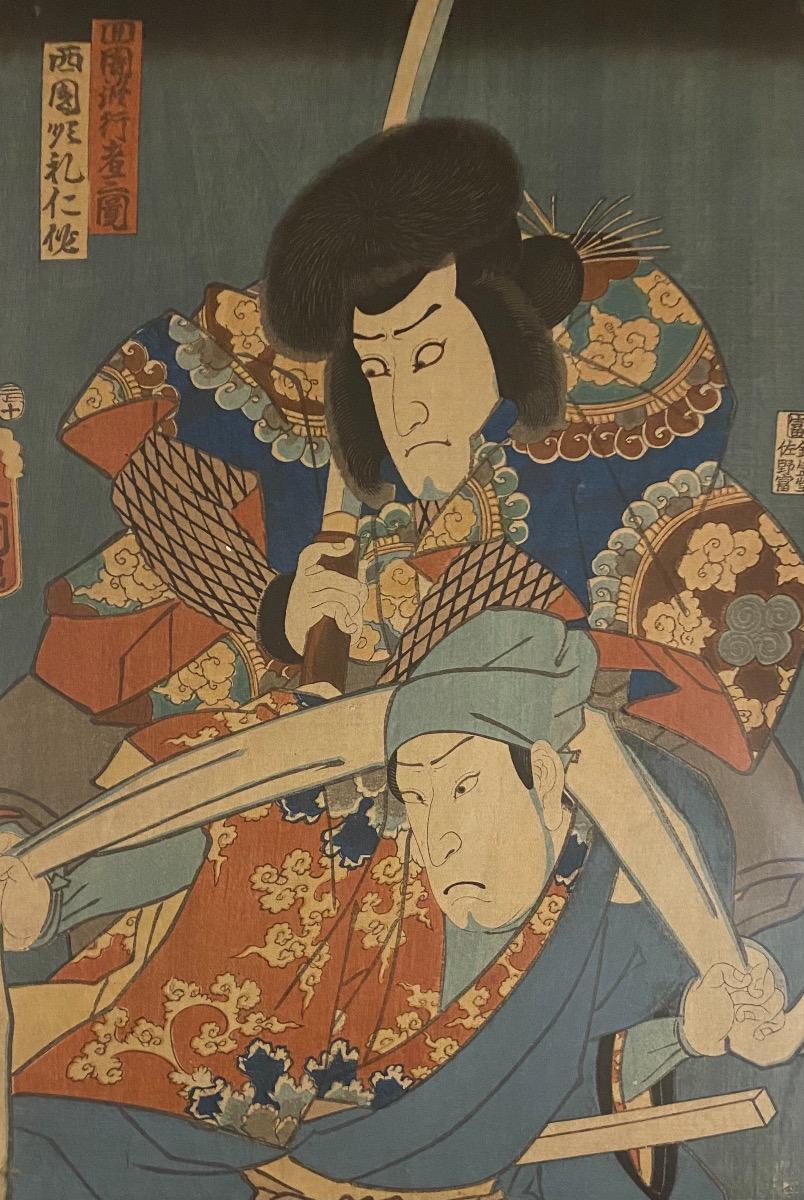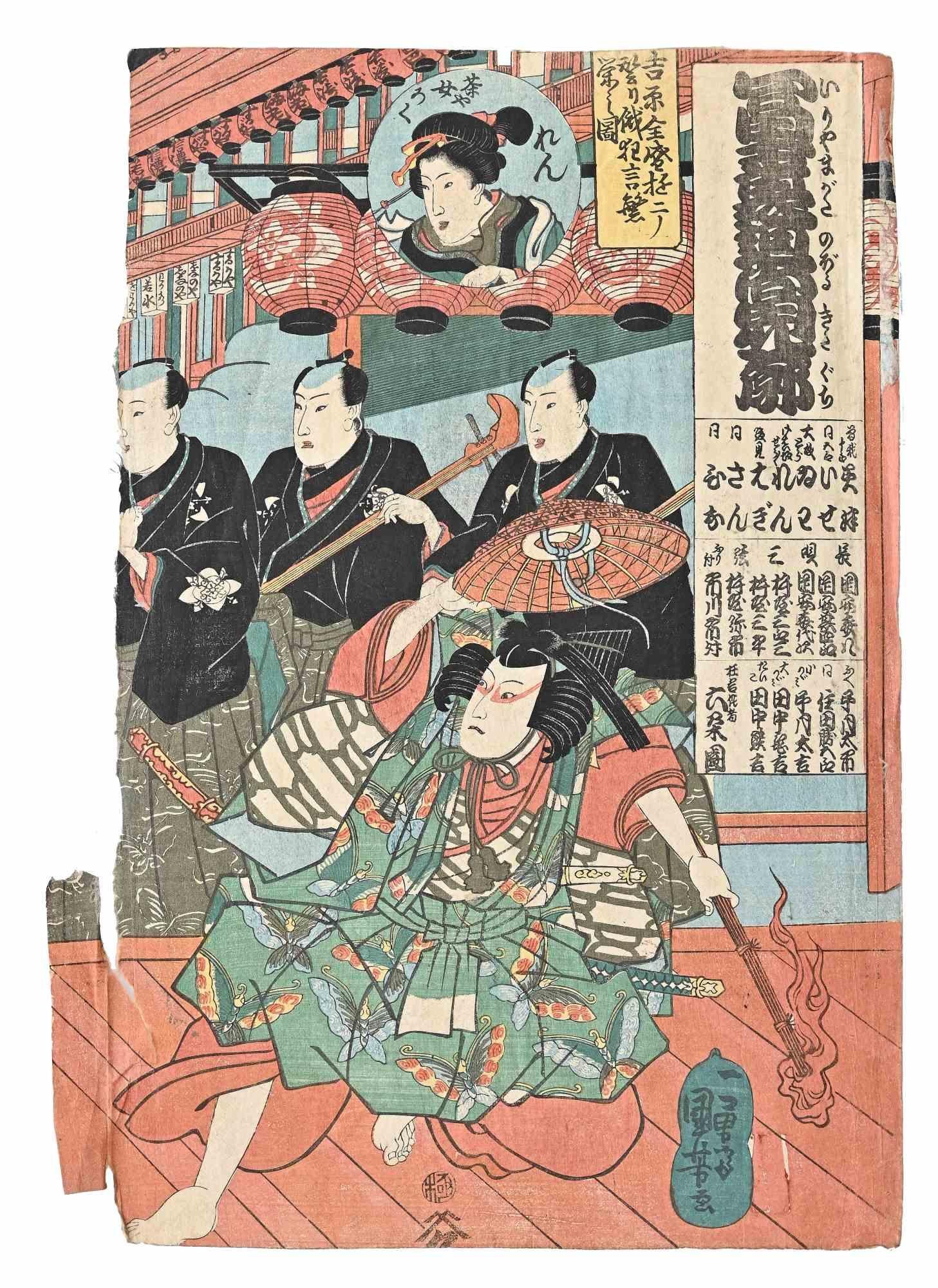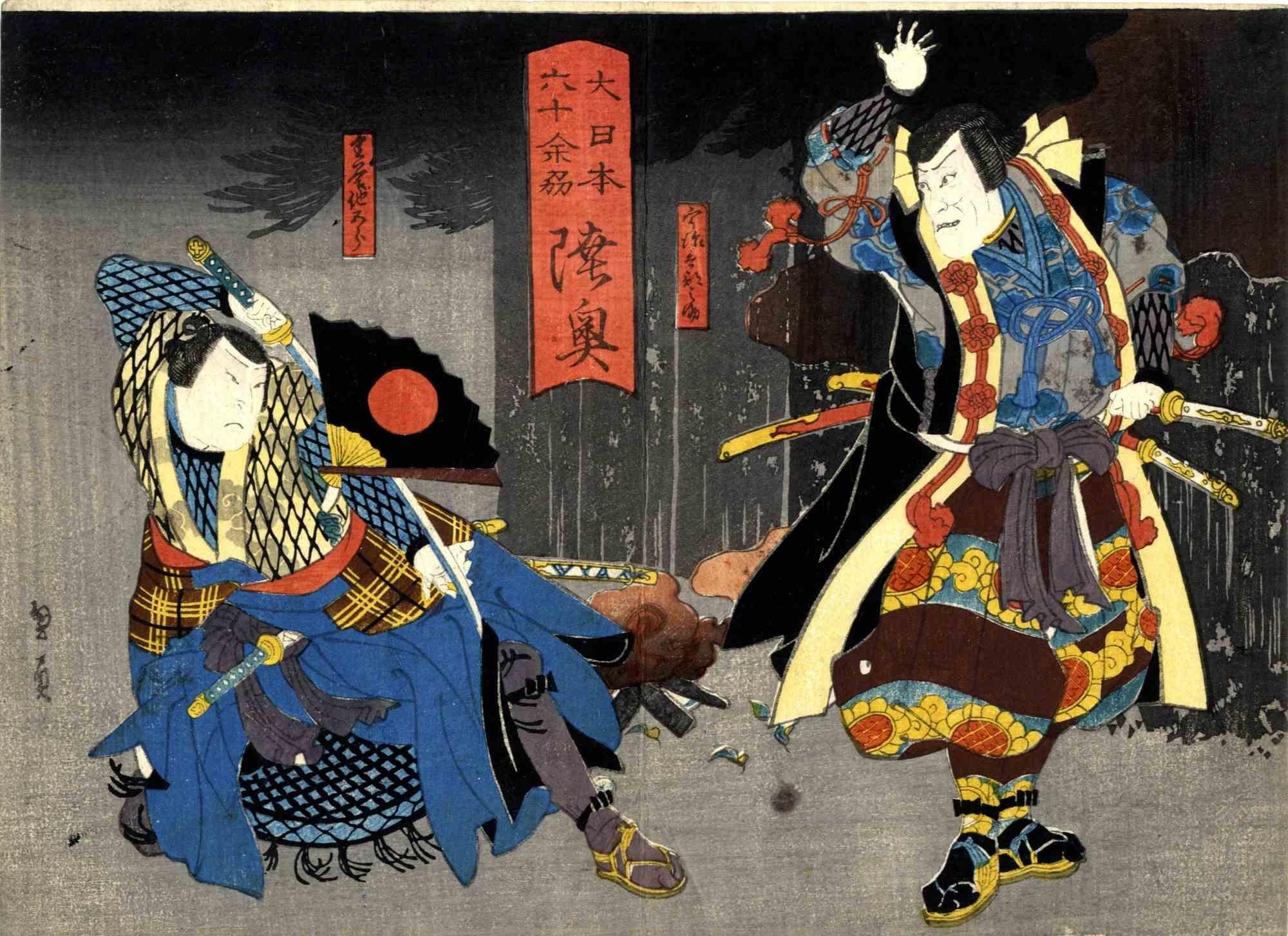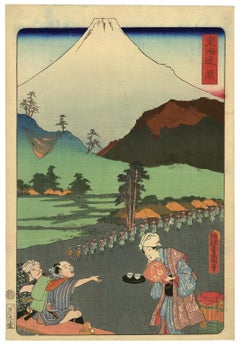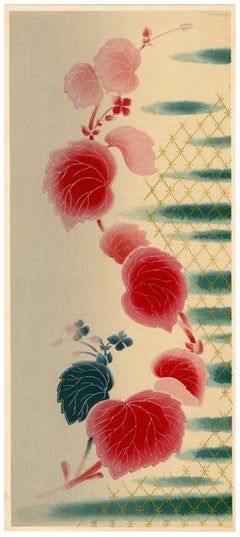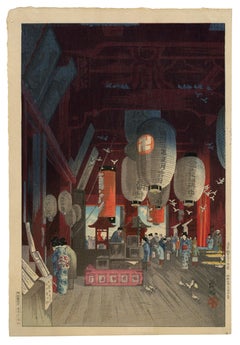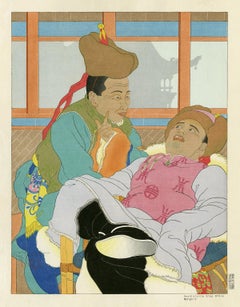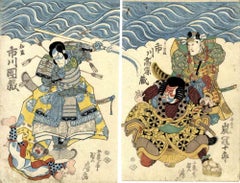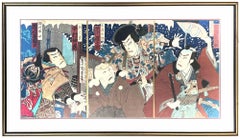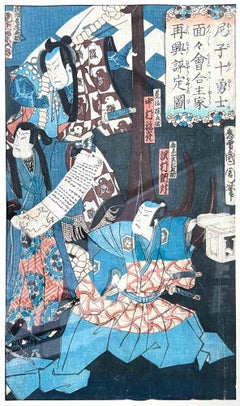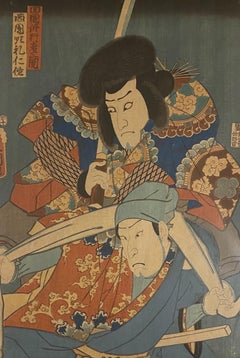Items Similar to 'Seven Actors in a Dragon Boat' — Edo period Kamigata Woodblock Print
Want more images or videos?
Request additional images or videos from the seller
1 of 3
Munehiro Hasegawa'Seven Actors in a Dragon Boat' — Edo period Kamigata Woodblock Printc. 1850
c. 1850
$550
£415.07
€475.19
CA$775.68
A$851.60
CHF 444.28
MX$10,305.58
NOK 5,568.40
SEK 5,246.89
DKK 3,547.18
About the Item
Munehiro Hasegawa, 'Seven Kabuki Actors in a Dragon Boat,' woodblock print, c. 1850, Osaka-e, Kamigata-e. Signed 'Munehiro' in the block, upper left. A fine impression with fresh colors, on Japanese paper with backing; a vertical center fold (barely visible recto); several professionally repaired worm holes (visible verso), otherwise in good condition. Scarce.
Image size/sheet size 9 1/2 x 14 1/4 inches (242 mm x 362 mm).
The image depicts seven kabuki actors as the Seven Lucky Gods riding on a dragon boat.
In Japanese mythology, the Seven Lucky Gods or Seven Gods of Fortune ( Ebisu, Daikokuten, Benzaiten, Bishamonten, Hotei, Fukurokuju, and Jurōjin) are believed to grant good luck, material abundance, and security.
Dragon boats in Japan date back to around 1390, when they were called Hari in Okinawa, the southernmost island. The most established account is that they were brought in from Fukien (Fujian) and Guangdong (Kwangtung), provinces in southeastern China on the East China Sea coast. Later, Hari boat races became a national event of the former Ryukyu (Okinawa) Kingdom and spread over the Okinawa Islands as an oceanic god festival for abundant fishing and safety.
The Osaka / Kyoto / Kobe area of Japan was called "kamigata" in the Edo period (1603-1867). The region had a significantly smaller population than the area around Edo, the capital. The ukiyo-e artists in kamigata specialized in "yaksha-e," depictions of actors and scenes from kabuki performances. The printmaking region developed a specialized style of print production distinguished by its skillful printing, luxurious color, and highly graphic imagery. The production numbers of these prints were much smaller than those of the Edo (capital) area and are consequently lesser known and more scarce.
This work is not the typical Osaka chuban diptych format but a single sheet with a vertical center fold, probably due to being folded into a volume of collected prints.
Although little information is available about the artist Munehiro Hasegawa (active 1850-1870), he is known for his prints of kabuki actors and is thought to have been a student of the famed Osaka printmaker Hirosada Utagawa.
- Creator:Munehiro Hasegawa (1850 - 1870, Japanese)
- Creation Year:c. 1850
- Dimensions:Height: 9.5 in (24.13 cm)Width: 14.25 in (36.2 cm)
- Medium:
- Movement & Style:
- Period:
- Condition:
- Gallery Location:Myrtle Beach, SC
- Reference Number:Seller: 982101stDibs: LU532316477572
About the Seller
5.0
Recognized Seller
These prestigious sellers are industry leaders and represent the highest echelon for item quality and design.
Platinum Seller
Premium sellers with a 4.7+ rating and 24-hour response times
Established in 1995
1stDibs seller since 2016
321 sales on 1stDibs
Typical response time: 1 hour
Associations
International Fine Print Dealers Association
- ShippingRetrieving quote...Shipping from: Myrtle Beach, SC
- Return Policy
Authenticity Guarantee
In the unlikely event there’s an issue with an item’s authenticity, contact us within 1 year for a full refund. DetailsMoney-Back Guarantee
If your item is not as described, is damaged in transit, or does not arrive, contact us within 7 days for a full refund. Details24-Hour Cancellation
You have a 24-hour grace period in which to reconsider your purchase, with no questions asked.Vetted Professional Sellers
Our world-class sellers must adhere to strict standards for service and quality, maintaining the integrity of our listings.Price-Match Guarantee
If you find that a seller listed the same item for a lower price elsewhere, we’ll match it.Trusted Global Delivery
Our best-in-class carrier network provides specialized shipping options worldwide, including custom delivery.More From This Seller
View All'Tokaido' — Mt. Fuji Rising – Mid-Nineteenth Century Woodblock Print
By Utagawa Kunisada (Toyokuni III)
Located in Myrtle Beach, SC
Utagawa Kunisada (Tokoyuni III), 'Tokaido', color woodblock, 1863. Signed in the cartouche, lower right. A fine impression, with rich, fresh colors and pronounced woodgrain, the full...
Category
1860s Edo Figurative Prints
Materials
Woodcut
Japanese Kimono Fabric Design — Vintage Color Woodblock Print
Located in Myrtle Beach, SC
Anonymous, Japanese Kimono Fabric Design, color woodcut, c. 1930. A superb impression, with fresh colors, fine graduations, and metallic gold motifs, on ...
Category
Early 1900s Showa Figurative Prints
Materials
Woodcut
'Interior of the Kannon Temple at Asakusa' — Tokyo Landmark, Early Edition
Located in Myrtle Beach, SC
NARAZAKI EISHO (1864-1936), 'Asakusa Kannon-do no naido' (Interior of the Kannon Temple at Asakusa), color woodblock print, 1932. Signed Eisho lower right, with the artist’s red seal beneath. A fine impression with fresh colors; the full sheet with slight overall age toning, a drying tack...
Category
1930s Interior Prints
Materials
Woodcut
'A Very Funny Story, Mongols' — Mid-Century Woodblock Print
By Paul Jacoulet
Located in Myrtle Beach, SC
Paul Jacoulet, 'Une Histoire très Drôle, Mongols', color woodblock print, 1949. A fine impression, with fresh colors, on the artist's handmade, personally watermarked Japan paper, in...
Category
1940s Showa Figurative Prints
Materials
Woodcut
'Peking - Paifang Gate' — Mid-Century Watanabe Color Woodcut
By Cyrus Le Roy Baldridge
Located in Myrtle Beach, SC
Cyrus Le Roy Baldridge, 'Peking '25', woodblock print, published 1926. Signed, titled, dated, and annotated 'No 124' in pencil. A fine impression, with fresh, undiminished colors; the full sheet, in excellent condition. Watanabe 6 mm seal, lower right, indicating an impression printed between 1945 and 1957. Archivally sleeved, unmatted.
Image size 9 5/8 x 14 5/16 inches; sheet size 10 7/16 x 15 3/8 inches.
ABOUT THE IMAGE
A 'paifang', also known as a 'pailou', is a traditional style of Chinese architectural arch or gateway structure. It has been theorized that the paifang gate architecture was influenced by Buddhist torana temple gates. Paifang are designed with traditional Chinese architectural motifs including multi-tiered roofs, prominent supporting posts, and gracefully arched openings.
This is an unusual ukiyo-e or 'floating world' woodcut published by Watanabe Shozaburo, Tokyo, in that the subject is of an early 20th-century scene in Peking, China.
ABOUT THE ARTIST
Cyrus Leroy Baldridge...
Category
1920s Showa Landscape Prints
Materials
Woodcut
Kintai Bridge at Iwakuni in Suo Province (Suo iwakuni kintai-bashi), 1859
By Hiroshige II
Located in Myrtle Beach, SC
Utagawa Hiroshige II (1829-1869), 'Kintai Bridge at Iwakuni in Suo Province' (Suo iwakuni kintai-bashi), from the series 'One Hundred Views of Famous Pla...
Category
1850s Edo Landscape Prints
Materials
Woodcut
You May Also Like
Actors - Woodcut Print by Utagawa Sadafusa - 1820s
By Utagawa Sadafusa
Located in Roma, IT
Actors is an original modern artwork realized in 1820-1830 by Utagawa Sadafusa.
Woodcut Print Oban Dyptich Format.
Arashi Kanjuro as Benkei, Ichikawa Komazo as Minamoto Yoshitsune ...
Category
19th Century Modern Figurative Prints
Materials
Woodcut
Kabuki Scene- Woodcut by Toyohara Kunichika - The Late 19th Century
By Toyohara Kunichika
Located in Roma, IT
Kabuki Scene is a Japanese multi-colored woodcut tryptich realized around the end of the 19th century by Toyohara Kunichika (1835 - 1900).
Original woodcut on paper. The artwork is ...
Category
19th Century Modern Figurative Prints
Materials
Woodcut
Kabuki Scene - Woodcut by Toyohara Kunichika - Late 19th Century
By Toyohara Kunichika
Located in Roma, IT
Kabuki Scene: Teramoto Life, Death Nosuke, Sawamura Bansho is a wooduct print realized by Kunichika Toyohara (1835-1900) in the late 19th Century.
In very good condition, includes ...
Category
19th Century Modern Figurative Prints
Materials
Woodcut
Japanese Actors - Woodcut by Utagawa Kunisada - 19th Century
By Utagawa Kunisada (Toyokuni III)
Located in Roma, IT
Japanese Actors is a superb colored woodcut realized in the XIX century by one of the most famous Japanese Ukiyo-e artists: Utagawa Kunisada, also know...
Category
19th Century Figurative Prints
Materials
Woodcut
Kabuki Scene - Woodblock Print by Utagawa Kunisada - Mid-19th Century
By Utagawa Kunisada (Toyokuni III)
Located in Roma, IT
Kabuki Scene is an original Woodcut print realized in mid 19th century after Utagawa Kuniyoshi (1797-1861).
Good condition and Beautiful colored woodblock print.
This wonderful mo...
Category
Mid-19th Century Modern Figurative Prints
Materials
Woodcut
Kabukie - The Province of Rokuok - Woodcut by Utagawa Kunikazu - 1862
By Utagawa Kunikazu
Located in Roma, IT
Kabukie - The Province of Rokuoku is an original artwork realized in 1862 by Utagawa Kunikazu (1830 - 1919)
Chuban.
From the series "Dai Nippon rokuju of Rikuoku" (60 provinces of Glorious Japan), The Province of Rokuoku.
Meeting of the two rivals in the forest at night, Tanigoro with sumo apron and fan with the national colours.
Signed: Kunikazu.
Good impression, backed, glued at corners, oxidation, centrefold, a little bit rubbed.
Utagawa Kunikazu (1830 - 1919) was a printmaker from Osaka. He had a famous teacher, the ukiyo-e artist Kunisada Utagawa...
Category
1860s Modern Figurative Prints
Materials
Woodcut
